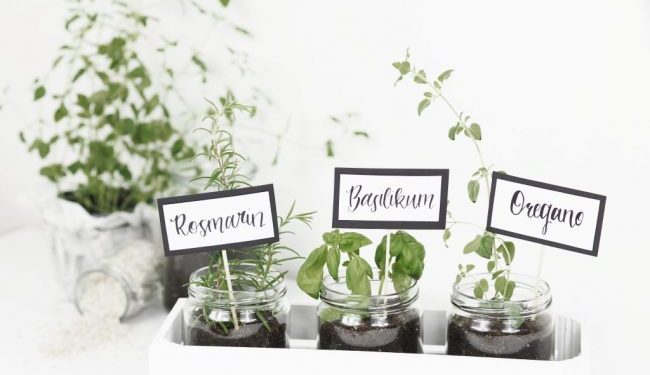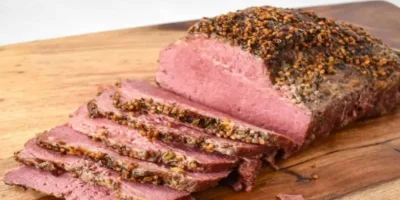This is how you can easily make a kitchen herb garden yourself step by step!
You don’t have a garden at home, but still want fresh garden herbs to cook or garnish at hand? Then if you make a kitchen herb garden it will definitely prove itself brilliant for every day.
Because having fresh herbs at home offers several advantages: it is cheaper, healthier and tastes fresher than dried or frozen herbs. By the way, they serve as great decorations in your kitchen and also smell wonderfully aromatic! If you want to spice up your delicious dish a little bit or garnish it beautifully, then your new homemade herb garden is perfect for it! Whether for tomato mozzarella, a herb quark or over the salad – fresh herbs can always be used, because their intense aroma makes them ideal for your kitchen.
Small tip: Kitchen herbs not only taste delicious – no, they can also have a soothing effect on pain, have a nourishing effect on our skin and ensure more well-being. The green leaves are therefore healthy due to their many vitamins and minerals.
Step-by-step guide for your homemade herb garden
Especially if you don’t have a garden or balcony or don’t want to walk outside all the time, you can easily bring your herb garden into the kitchen – and without much effort and space make a kitchen herb garden. While cooking, you simply take a few leaves of the herbs at any time and have a tasteful meal and you can also use them for home remedies.
You need:
- Mason jars
- Wooden tray or wooden box
- High-quality potting soil or special herbal soil
- Glass stones, gravel or pebbles
- Various herbal seedlings or cuttings of your choice
- Shashlik sticks
- Black craft paper
- Copy paper
- Glue
- Tie strips
Step 1: First, when you make a kitchen herb garden, you should consider which herbs you would like to plant. Get the small plant in a garden centre or your nursery. Here you can also buy the earth and the decorative or pebbles. Alternatively, you can dig a small plant out of a conventional herb pot from the supermarket. There are just as many possibilities for the vessels: I have taken jars, but pots made of clay or terracotta as well as cans are also a great alternative.
Step 2: First you wash off the decorative glass or pebbles and then fill them about 3 cm high into the glass. So the rest of the water from the watering does not accumulate and the herb plant can take as much liquid as it needs. Fill the glass about half with potting soil. Now insert the cutting, fill the remaining glass with soil and press it well. Plant one plant in a glass, because it will still spread quite a bit and take up a lot of space.
Step 3: If you want to decorate, make nice herbal signs. Then it is immediately recognizable which type of herbs is in the glass. Write the name of the herb handwritten on kraft paper, cut it out and glue it with tesa strips to ashashlik stick. You can also try hand lettering to draw the letters on white copy paper. Or just use our free download template. Print it out, cut out the shield and glue it onto black kraft paper, which you then cut out again. With ties, you stick it to the shashlik stick and put it in the earth in the glass.
Step 4: Now all you have to do is water your planted herbs to make everything grow well. Place them in the wooden box and, depending on the plant, to the appropriate locations (see tips below). Now you can watch your plants grow, harvest them after some time – and enjoy them.
5 plants and recipes for your herb garden
I particularly like to take these five herbs and must not be missing in any kitchen!
Basil: It is relatively easy to care for and excellent for your indoor herb garden. Basil feels most comfortable when it gets a lot of light and warmth, but no constant, direct sun. It prefers the semi-shade and needs a lot of water, but waterlogging should be avoided. If possible, pour it a bit every day.
Parsley: This plant thrives best in semi-shade with a lot of moisture. She likes a lot of light, but not too much direct sun. It refines all dishes, whether raw or steamed. Be sure to heat the parsley only briefly, otherwise its aroma will be lost.
Rosemary: It needs a lot of sun and gets by with relatively little water. Too much moisture can even be harmful to him, so make sure he has it rather dry and don’t water too much. On the south side of your window sill, it would get enough warm sunlight. After flowering or in winter, it should be cut back so that it is fresh again in spring.
Rosemary is particularly good for potatoes. The healthy tuber can be easily prepared in the oven together with the green herbs.
Chives: If well maintained, it can even be harvested all year round. Chiunde feels most comfortable in semi-shade and in moist soil. Therefore, water it sufficiently so that the tube leaves do not dry out. Whether in the omelet for breakfast, for garnishing salads and other meals or on the cream cheese bread – chime tastes to many dishes and is versatile.
Mint: It is best to stand in semi-shade and always have moist soil. Especially in summer you can use these green refreshing leaves for different recipes. For example, you can use it to make a healthy, aromatic infused water. Many desserts, dishes and drinks can also be garnished with it.
Which herbs are suitable?
If you want to prepare a delicious dip, you can take wild garlic, for example. Oregano belongs in your spaghetti bolognese and for cucumber salad dill fits wonderfully. But also for tea are the herbs, which you can refine with sage, mint or lemon balm. Here are other kitchen herbs that are suitable for a variety of meals:
- Oregano
- Thyme
- Tarragon
- Marjoram
- Wild garlic
- Dill
- Cress
- Lemongrass
- Lemon balm
- Sage
- Lavender
Which location is best suited?
Where you best place your indoor herb garden depends on the plant. Most are relatively undemanding, but there are exceptions. The best location for your herb plants varies from variety to variety. Depending on the orientation of your kitchen window, you may be able to place it on your window sill or on another open space in your kitchen. Rosemary, thyme, lavender or sage prefer it a little sunnier and warmer. Oregano and Marmajoran also tolerate the sun well. Large-leaved plants such as mint or basil, but also tarragon, chives and parsley like a little more semi-shade. Some herbs should also be protected from direct sunlight, e.g. mint or lemon balm.
Tips for the care of your herbs
- Select a suitable size of the vessel for the respective plant. If you ever plant a cutting, a 1-litre vessel is just right, but you can also take a slightly smaller vessel.
- Water them regularly, but not too often, because there should be no waterlogging. Most herbs need a lot of moisture, so look for them every day and irrigate them as needed. The leaves should not get wet, so pour the water directly onto the earth. Thyme, oregano or rosemary do not require quite as much water. Lemon balm, chives, tarragon, peppermint and basil thrive best with a little more moisture.
- Tip: In garden centres there are usually free booklets or small plugs directly on the plant, which contain care tips especially for the respective plant.
- Although they look beautiful, it is recommended to remove the flowers immediately, otherwise they will take away a lot of strength and taste from the plant. Damaged or dead stems and leaves can be cut off and thrown away again and again.
- The best way to harvest is to use a sharp knife or scissors. Take here relatively young shoots, because herbal plants can better recreate new ones. Nevertheless, it would be important that a few leaves remain, otherwise the plant will no longer expel. As a rule, you should leave about half or two-thirds of the leaves standing. Especially chise and parsley should be cut off quite close to the ground so that they can grow well.
- Fertilize your herbs a few weeks after you have planted them at regular intervals. Here you can easily use old eggshells or coffee grounds, which are always left over. Alternatively, organic herbal fertilizer, which is added to the water for water ingess, is a good choice. This provides the plant with sufficient nutrients and gives off a better aroma.
- Some plants can be planted, cared for and harvested all year round. Others need a winter break so that they can expel fresh in spring. You can cut them back in autumn and freeze or dry them in small portions to make them durable. Place them in a bright, cool room over the winter, sometimes pour them and no longer fertilize.
- If the herbs grow over your head, freeze or dry them as well. Then they can still be used later.




